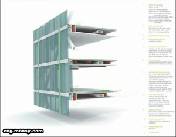DOUBLE SKIN FACADES 1 from 3

SOLUTION FOR ENERGY EFFICIENT BUILDING OPERATIONS
The building industry is one of the biggest consumers of energy across industries. Due to increasing concerns about depletion of fossil fuel reserves and natural resources, the industry is constantly in the lookout for innovative building materials that can reduce the consumption of energy.
One such promising invention is the Double Skin Facade (DSF).
While DSFs have been used to a large extent in Europe for aesthetics and acoustics, a growing section of the building industry also believe that using DSFs in large buildings can improve the overall energy efficiency of a building by passive solar heat gain in winter reducing thermal losses in winter reducing overall solar heat gain (in summer) and support of natural ventilation (with the stack effect).
What are Double Skin Facades?
Facades work as a building envelope apart from lending character to the entire building smart and innovative facades can provide significant energy savings. Innovations in glazing have already made heat absorbing glass, reflective glass and double glazing commonplace, with an associated set of aesthetic features.
In the last few years, the architect and building community have been looking at combining these aesthetic elements with natural elements such as wind and climate along with intelligent mechanical solutions to make these facades more responsive to outdoor and indoor climates.
Improved shading and solar control systems, greater use of automated controls, and integration with other building systems are some instances of such experimentation.
The Double Skin Facade (DSF) is one example that can provide improved acoustics, better solar control and enhanced ventilation.
The double skin facade incorporates the passive design strategies of natural ventilation, day lighting and solar heat gain into the fabric of the high-rise building.



